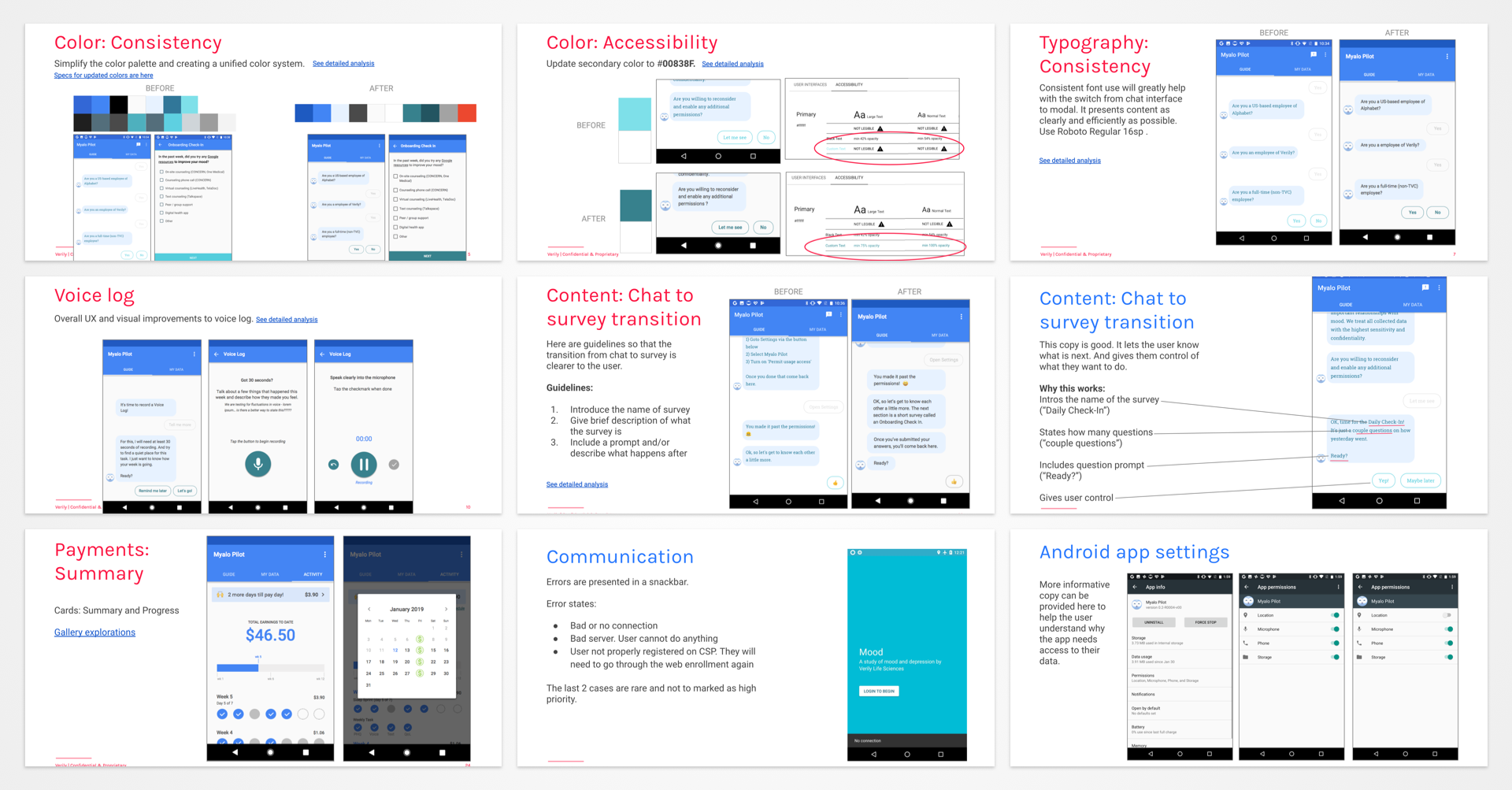
product design
Google Verily Life Sciences
MYaLo: A MOod StuDy App
MY ROLE: Design Lead
THE GOAL: Design a mobile app designed to motivate users to record their persoanl data.
THE CHALLENGE: Building trust with users.
THE APPROACH: I conducted usability testing of characters, use of animated gifs, and chatbot interface to inform the design of mobile app flows and screens.
THE RESULTS: Myalo app was released to 5,000 participants. Engagement of participants increased with the redesign of chatbot interface. Development time increased by implementing a standard reusable component library.
- User Flows
- UI Design
- Mobile Design
- Wireframing

Developing digital biomarkers for depression
Myalo is a 12 week app-based study of over 5,000 participants with the intent to use their smartphones to measure mood in real-time so that clinicians can proactively improve treatment of depression.
Starting with the hypothesis that quantified changes in behavioral patterns will offer early, objective markers of depression, Myalo will capture both passive and active data from participant's smartphones to predict depression risk and progression.
Myalo solves two systemic problems in mental health: scalable early detection and unobtrusive measurement. One on five Americans suffer from depression. Depression is the number one cause of disability worldwide and is an $800 billion global economic burden. In addition, United States suicide rates grew 25% from 1999-2016, and that number is increasing.
To measure the early detection in individuals, we decided to utilize passive sensors to develop a data-driven measurement tool that can be seamlessly woven into day-to-day life. Phone sensors were used because they are more ubiquitous, scalable, and unobtrusive than any other hardware sensor.
The information collected was for study purposes only. Passive phone sensor data included activity data, such as step count and movement, location data, phone usage data, such as screen, network, and battery use.





Designing for the user
The Myalo app used a chatbot interface that led participants through the study – users never had to guess what task was next – and chat offered a familiar interface for quickly inputting data.
The use of emojis and animated gifs offered a lightness in personality and tone in the app. Users found this more friendly and delightful. It helped connect the user, as well as lower the burden of data input since the app required a high burden of completing daily tasks.
Participants were expected to spend, on average, five minutes or less every day on study tasks. Data collected included both survey responses and phone sensor data.







Return of Results
Participants were asked to complete daily tasks, in the form of surveys and voice logs, for 3 months. Participants were given the option to complete monthly surveys for 9 additional months – 12 months total. To encourage adherence, participants were paid for each study task. We also offered a return of their results as an important lever for improving adherence.
There were three types of data that was returned to participants:
• Study task completion
• Study compensation (tied to study task completion)
• Data from “active” self-reported surveys (e.g. PHQ-9, mood EMA, sleep sprint)
The Myalo app was designed with three tabs or sections:
• GUIDE: chat interface where all study tasks are surfaced and completed
• MY DATA: return of data
• ACTIVITY: study task completion + compensation info


Specs, Accessibility, and Proposals
I created a UX and and visual audit of the app as part of the cleanup for the larger launch. Once UX and visual design were finalized, I created specifications and documentation.
Color and font consistency and accessibility were drivers for the larger app release.





